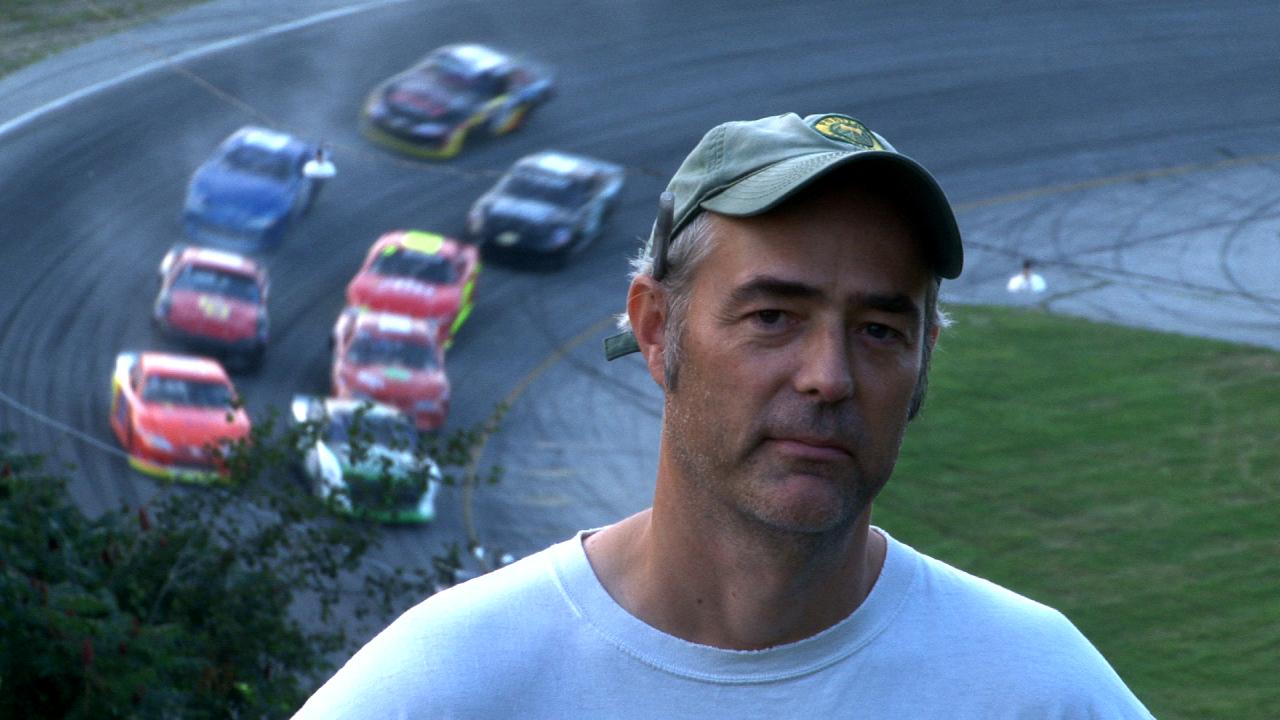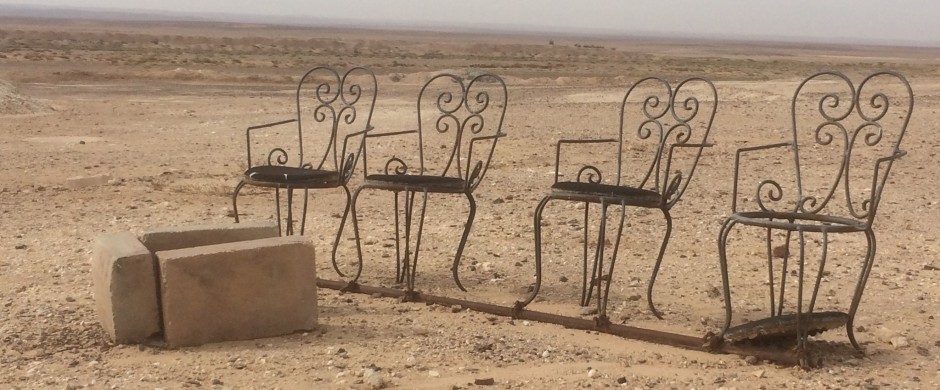X
"Short Track Short Cut"— a mobile phone video collage. Post your own video to UnitedShortTracksofAmerica.com. Here are the rules. | "Circular Logic" — an essay (with audio) |
By Erik E. Esckilsen
One sunny Sunday in October of 2000 — it had to be the most agreeable autumn day that year, maybe of any year — I took Robert Frost’s advice about the road less traveled and traveled in the completely opposite direction that Frost would have traveled had he been there, on that day, to see the Vermont foliage at its peak. Instead of heading into the crimson- and gold-dappled hills to hike or meander in quite contemplation, I went to a stock car race.
The setting: Thunder Road International Speedbowl in Barre, Vermont — the self-designated “Nation’s site of excitement.” That day’s race program included the season’s finale, the coveted Milk Bowl. A quarter-mile asphalt track roaring with engine noise inspires little reflection on the beauty of the changing seasons. But change was definitely in the exhaust-tinged air, and I’m grateful to have been there to breathe it in. Inspiration struck me that day — struck with the force of a racecar slamming into a wall.
A racer by the name of Tracie Bellerose was on her way to winning the Thunder Road track championship in the Late Model division, the top tier. I wasn’t really much of a fan — of Bellerose or of auto racing, for that matter — but I decided to concentrate on her car as she ran, if for no other reason than to witness the novelty of a woman racecar driver in a male-dominated sport.
A few laps into Bellarose’s first race I could see why the season had been hers. She was clearly the best driver out there: patient, persistent without being reckless, and immovable from any piece of track she claimed. Two other aspects of her racing persona, I came to discover, added to the buzz about Bellerose: First, obviously, she was a woman; and, second, she was from New Hampshire. As a native Vermonter, I wasn’t sure which of these characteristics represented the greatest challenge to the Thunder Road status quo. Vermont has had a rivalry with New Hampshire for a long time. It’s a long story, and it goes back, oh, a couple hundred years. For these and possibly other reasons, Bellerose’s racing skill stoked a curious energy coursing through the grandstand.
In Vermont terms, Barre is known as a relatively conservative city, politically speaking, and that particular Milk Bowl was taking place in an election year at the zenith of the statewide civil unions debate. Now that full marriage rights are accorded gay couples in Vermont, the civil unions dust-up makes this episode seem like a distant one indeed. Several candidates for office were at the track that day to impress the electorate with their cow manure-tossing prowess during an intermission stunt — among them Karen Kerin, transgendered Republican candidate for Bernard Sanders’s seat in the United States House of Representatives. She didn’t win. Sanders would hold his House seat until he was elected to the United States Senate.
I still can’t quite identify the odd phenomenon that I experienced that day, but I remember walking away with a blend of impressions that could — maybe should — add up to something. Whatever form it took, it would have to do with the excitement of auto racing, community, gender, and a bold challenge to the existing order. It was the germ of a story; I could tell. But what story, specifically? I didn’t know.
And I wouldn’t know for a few years, but the longer the memory of that day lingered, losing vividness of detail but gaining in a sense of possibility, I became more confident that some story would emerge. At some point, for reasons quite mysterious to me, the time to take a run at the story arrived. I strapped in and dropped the green flag. The narrative took off, and I was just along for the ride.
Thanks to Tom Curley and his staff at Thunder Road, I enjoyed access to the pits, was introduced to drivers, and was even able to drive a car around the Road’s high-banked turns a few times. Soon enough, I’d have the chance to acknowledge my gratitude for their help — inside the cover of my third novel for teenage readers, The Outside Groove, which was published in hardcover by Houghton Mifflin and later released as an e-book. The book’s main character is a young woman who learns to race stock cars as a way of asserting herself in a community where she’s overshadowed by her older brother, the fictional town’s next great hope at big-time racing glory.
I think I had more fun writing The Outside Groove than I’ve ever had writing anything, and that’s probably because the research was so much fun. Like my main character, Casey LaPlante, I was sometimes overwhelmed to learn how much more there is to stock-car racing than driving around and around in circles — ovals, actually.
I also learned a great deal about writing working on The Outside Groove. One lesson I’d actually learned before, when I spent a day with five Mohawk teenagers in upstate New York as research for my second novel, Offsides. It’s a lesson worth revisiting: The price of staying corked up at the writing desk too long, instead of meeting new people and finding out what they do, can be a missed opportunity to enrich the writing process and bring a story to dynamic life.
I was also reminded of something important about the shape of stories in writing The Outside Groove: that the best place to end a story may be when a new, maybe even more transformative story is about to emerge for the characters — not when their problems have been solved, in other words, but when new, even bigger problems appear on the horizon.
Finally, I came to a deeper understanding of stories — at least in their earliest stages — not so much as hypothetical events arranged in the more or less linear shape that we recognize as a narrative but as a set of disorganized possibilities — questions that I either am or am not interested in pursuing. The promise of a story concept, for me, is a measure of the allure of these questions. If, over time, these questions not only stick with me but engender other questions, then I know I have a story that will sustain my interest for the long haul — and maybe even bring forth my best effort.
It’s up to readers to determine whether I’ve succeeded. But even though The Outside Groove is finished, in the sense that you can buy it online and elsewhere, I saw something during my research that continues to haunt me, like those questions that loom on the horizon at a story’s conclusion.
One evening, in the midst of writing The Outside Groove, I was driving to Thunder Road when I passed a truck headed in the opposite direction. The truck was pulling a trailer with a mangled racecar on the bed. It was early in the evening, so I figured the driver had either failed to qualify for his division’s featured race, or he’d wrecked seriously enough to be out of contention. Either way, I could tell from the look on his face he was very, very unhappy.
But what struck me most wasn’t the driver’s scowl so much as the look on the face of the little girl sidled up next to him. Eight, maybe nine years old, she wore a sad expression that revealed, in the private moment I was witnessing, depths of some undifferentiated feeling. That’s a pretty stale way of saying that, in that instant, my mind raced with questions about what she was experiencing: Was she sad because she knew how much her father looked forward to the race night, tinkering with his ride after work all week long? Was she sad because she didn’t know how to cheer him up when he got so down? Did she wish her mother, whoever she was, wherever she was, were there with them?
I can’t hold a copy of The Outside Groove in my hand now without thinking of that little girl, even though she’s not in the book. While it’s unlikely our paths will cross again, I know I’ll see her in a story. I know this because I’m still thinking about her. The story setting will probably be a racetrack like Thunder Road, because I can’t seem to get that place out of my head either.
Erik E. Esckilsen is the author of three novels for teen readers, all from Houghton Mifflin / Walter Lorraine Books: The Last Mall Rat; Offsides; and The Outside Groove, which is now available as an e-book. For more information, visit www.outsidegroovenovel.com or www.erikeesckilsen.com.
Music on the recorded version of this essay, “Snake Spoke,” was provided by Lucio Menegon from Soundtrack Instrumentals (Music for Driving & Film, Vol. 1) — www.kingtone.com
Radio announcer XX is featured on the recorded version courtesy of videographer XX of Big Jim’s videos — www.jerseyracing.com
